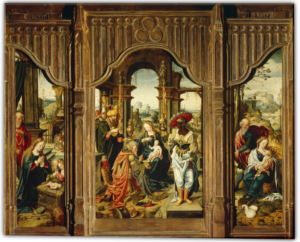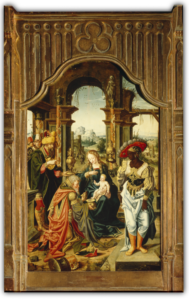Object of the Month: December 2019
Triptych: Nativity, Adoration of the Magi, Flight into Egypt
Oil on panel
Jan Swart van Groningen
As his name states, Jan Swart came from the town of Groningen in the Netherlands. No documents tell of his training, but this painting depicts his fondness for showing people in unusual headgear. It also reveals his other work as a book illustrator. Here Swart pictures the central truth of Christ’s coming into the world, placed within the context of His early life.
M&G’s Triptych (three panels) illustrates three events in Christ’s early life: the Nativity, Adoration of the Magi, and the Flight into Egypt. The birth of Christ signified the coming of a new covenant—a covenant that forever removed the necessary demand of the Old Testament Law requiring atonement for sin before the joy of reunification and fellowship with God.
Swart unifies the three stories of the triptych through a key motif: broken architectural elements. The left panel (clearly the stable with a curious cow in the background) has the Christ-child lying on a manger of ornate stone, possibly the base of a larger pillar. But the broken pillar at the base of the marble manger (right foreground) catches the viewer’s attention because its decoration is too fine to be part of a stable and because it matches all the other pillars, especially the broken one in the foreground of the Adoration. In the Flight, the Madonna and Child are resting on a pillar’s base by the side of the road. In each panel then, Swart uses the broken columns to point to Christ’s reason for coming to earth.
However, Swart develops his illustration of the Scriptures even more, specifically within the large, middle panel. The Adoration is central to an understanding of that New Covenant that Christ came to establish. To appreciate his storytelling, one must carefully consider the motif of the number 3.
Three in Composition
Swart adorns the frame of the middle panel with a trefoil centered over the Madonna and Child. This iconography tells the viewer that the scenes are the story of the One God in Three Persons, the Trinity of which Christ is the second Person. Swart then emphasizes this truth through more tripling in the work. There are three openings in the room, which is clearly not a stable. In doing so he follows the same Scriptural distinction that the Magi came to “the house where the young child was.” Interestingly, each opening emphasizes a key character in the story:
- The left doorway holds the third magus as well as some other apparently well-to-do men, based on their clothing.
- The middle opening, framing the Virgin’s head, shows some soldiers in the background. Their presence alludes to Herod’s men, who were tasked with murdering the male infants in Bethlehem to prevent Christ from becoming king—the reason the family fled to Egypt.
- The right opening frames a large building in the distance with townspeople going about their business, unaware or uncaring about the visit of such prestigious visitors to their village and to the Savior of the world. The full, frontal view of the first magus in his ostentatious dress already makes him a focal point, but the opening behind him seems to frame him as if he were posing for a portrait.
Three Gifts
Swart does not include Joseph in this panel, though Christ’s earthly father is often part of this family scene. The reason is that the focus is on the heavenly family of the Christ. The three gifts of the magi emphasize a different family than that of Joseph’s.
- Gold is a gift for a king and points to Christ’s position as the King of heaven who will be rejected and killed by His lawful subjects.
- Frankincense, a gift for deity, represents the fact that Christ is the God of heaven who will not only be the priest who offers the sacrifice for sin but will also be the sacrifice itself.
- Myrrh is a burial oil symbolizing the death that will be necessary to establish the New Covenant of grace. It also emphasizes the unbelievable story of the Christ: The King of heaven and the Creator of the world will die for those who owe Him everything and will allow them the exercise of their free wills to reject or accept Him.
Christ’s lineage through Joseph is that of the kings of Israel, perhaps another reason that he is not present: Christ’s royal claim to these kingly gifts relies on His eternal lineage, not that of His earthly father’s.
Three Magi
The three holders of the gifts are also interesting to note. Those held by the two Magi on the side are urn shape, commensurate with their gifts of oil. Logically then, the wide-mouthed lidded bowl offered by the central magus is the gold: the kneeling pose and the type of gift indicate the submissiveness of a subject to a king. Christ’s pose and gesture indicate His position as both king and priest in extending a blessing to His subjects.
Three Columns
The three ornate pillars within the middle panel are interesting as they are in differing conditions. The pillar in the foreground matches the one in the stable. But the other two frame the Christ and His mother. Perhaps Swart is showing the progressive nature of the New Covenant’s institution. One column is broken, another is empty, and the third fulfills its purpose. Christ must be born, die, and resurrect in order to complete the New Covenant. Swart again uses the number three to tell the story of Christ, even as an infant, has set in motion the redemption of the world.
Dr. Karen Rowe, M&G Board Member
Published in 2019

